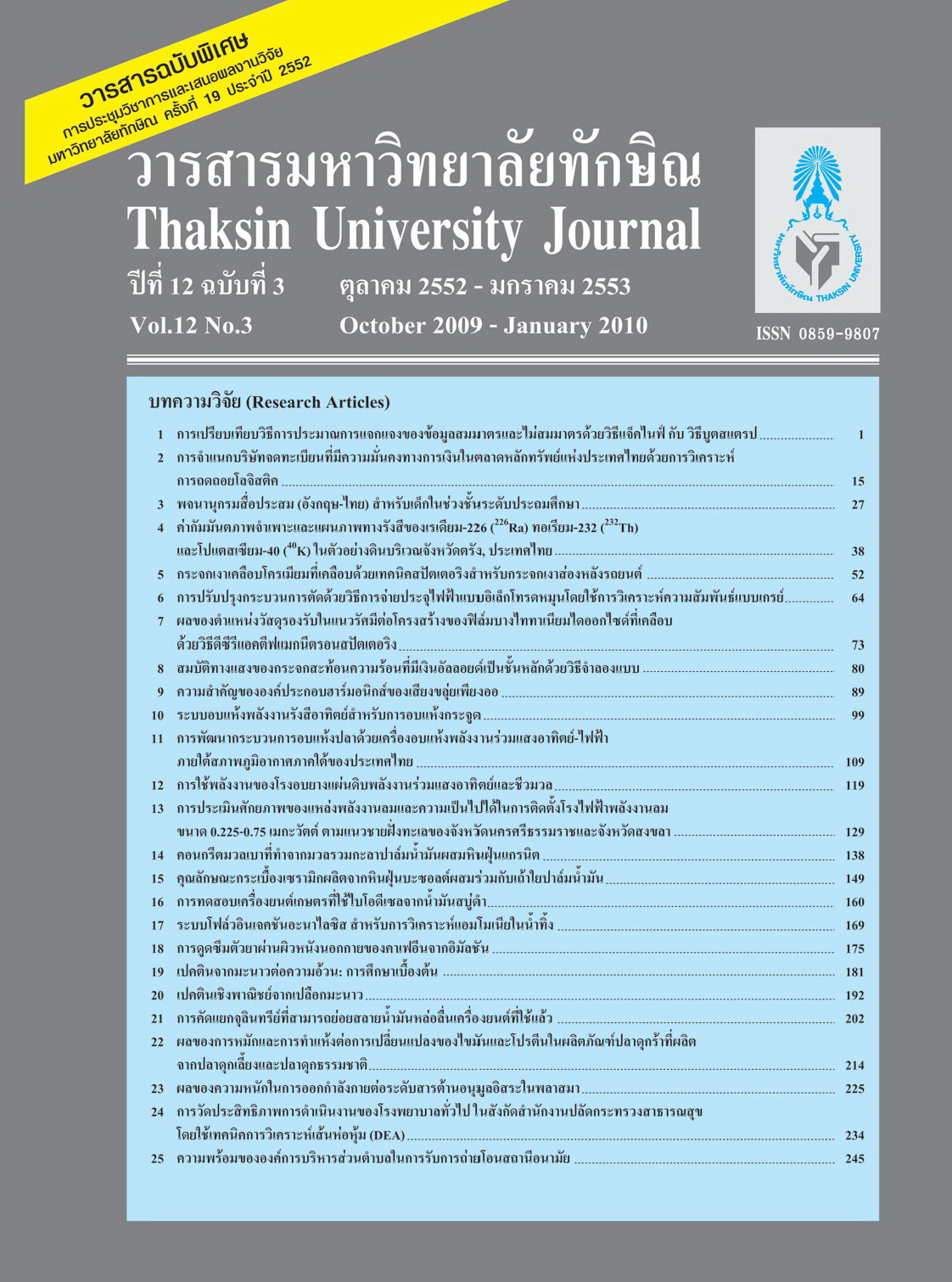สมบัติทางแสงของกระจกสะท้อนความร้อนที่มีเงินอัลลอยด์เป็นชั้นหลักด้วยวิธีจำลองแบบ
Main Article Content
Abstract
ฟิล์มบางเงินมีสมบัติทางแสงที่ดีเหมาะสำหรับเป็นชั้นสะท้อนอินฟราเรดของกระจกสะท้อนความร้อนที่มี โครงสร้างแบบ TiO2/Ag/TiO2 อย่างไรก็ดีฟิล์มบางเงินเสื่อมสภาพได้ง่ายเมื่อสัมผัสแก๊สออกซิเจนในระหว่างการ เคลือบ ปัญหานี้แก้ได้โดยใช้เงินอัลลอยด์แทนเงินบริสุทธิ์ บทความนี้เป็นรายงานการศึกษาความเป็นไปได้ในการใช้ ฟิล์มบางเงินอัลลอยด์เป็นชั้นสะท้อนอินฟราเรดของกระจกสะท้อนความร้อน โดยเคลือบฟิล์มบางเงินอัลลอยด์ และฟิล์มบางไททาเนียมไดออกไซด์ ที่มีความหนาเท่ากับ 30 nm บนกระจกสไลด์ด้วยระบบดีซีแมกนีตรอน สปัตเตอริง เพื่อใช้หาค่าคงที่ทางแสง (n และ k) ด้วยโปรแกรม TFCalc ซึ่งเป็นโปรแกรมสำหรับออกแบบฟิล์มบางแสง พบว่าที่ความยาวคลื่นแสงเท่ากับ 500 nm ฟิล์มบางเงินอัลลอยด์มีค่า n= 0.05 และ k = 2.92 ขณะที่ฟิล์มบาง ไททาเนียมไดออกไซด์มีค่า n= 2.38 และ k = 0 โดยค่าการส่งผ่านแสงจากการจำลองแบบด้วยโปรแกรม TFCalc เมื่อแปรค่าความหนาชั้นเงินอัลลอยด์ของกระจกสะท้อนความร้อนที่มีโครงสร้างแบบ TiO2(30 nm) / Ag-alloy(x) / TiO2(30 nm) สรุปได้ว่าฟิล์มบางเงินอัลลอยด์มีศักยภาพที่จะนำมาใช้เป็นชั้นสะท้อนอินฟราเรดของ กระจกสะท้อนความร้อนได้
Silver thin films possess many excellent optical properties; it is suitable for use to be an IR-reflected layer of heat reflection mirror with TiO2/Ag/TiO2 structure. However, it easily degrades when exposed to oxygen gas during the deposition sequence. This problem may be solved by using Ag-alloy instead of pure Ag. This paper presents the results of the feasibility study to use Ag-alloy thin film as an IR-reflected layer of heat reflection mirror. Thin films of Ag-alloy and TiO2 thin film with a thickness of 30 nm were deposited on slide glasses by DC magnetron sputtering. The optical constants (n and k) of Ag-alloy and TiO2 thin films were evaluated by TFCalc, the optical thin films design software. The optical constant of Ag-alloy thin film, at 500 nm, are n= 0.05 and k = 2.92 while TiO2 thin film are n= 2.38 and k = 0. The simulated results of the transmittance from TFCalc, that varies with the thickness of Ag-alloy layer of heat reflection mirror with TiO2(30 nm) / Ag-alloy(x) / TiO2(30 nm) structure, it can be concluded that Ag-alloy thin film could potentially serve as an IR-reflected layer of the heat reflection mirror.


